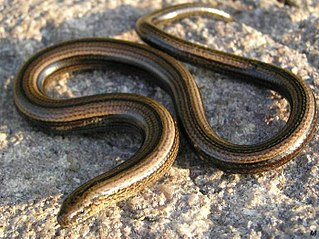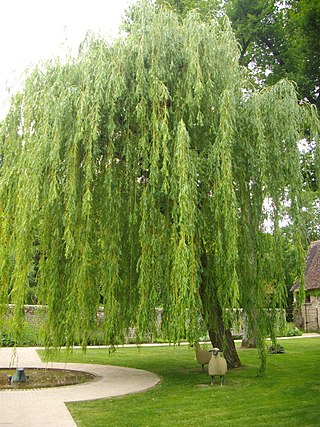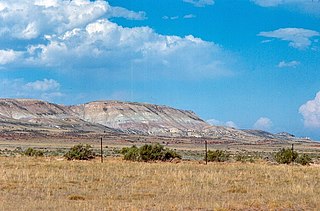
Allosaurus is an extinct genus of large carnosaurian theropod dinosaur that lived 155 to 145 million years ago during the Late Jurassic period. The name "Allosaurus" means "different lizard", alluding to its unique concave vertebrae. It is derived from the Greek words ἄλλος and σαῦρος. The first fossil remains that could definitively be ascribed to this genus were described in 1877 by famed paleontologist Othniel Charles Marsh. The genus has a very complicated taxonomy and includes at least three valid species, the best known of which is A. fragilis. The bulk of Allosaurus remains have come from North America's Morrison Formation, with material also known from the Lourinhã Formation in Portugal. It was known for over half of the 20th century as Antrodemus, but a study of the abundant remains from the Cleveland-Lloyd Dinosaur Quarry returned the name "Allosaurus" to prominence. As one of the first well-known theropod dinosaurs, it has long attracted attention outside of paleontological circles.

Salix × fragilis, with the common names crack willow and brittle willow, is a hybrid species of willow native to Europe and Western Asia. It is native to riparian habitats, usually found growing beside rivers and streams, and in marshes and water meadow channels. It is a hybrid between Salix euxina and Salix alba, and is very variable, with forms linking both parents.

The slowworm is a legless lizard native to western Eurasia. It is also called a deaf adder,slow worm, blindworm, or regionally, a long-cripple and hazelworm. The "blind" in blindworm refers to the lizard's small eyes, similar to a blindsnake.

Salix babylonica is a species of willow native to dry areas of northern China, but cultivated for millennia elsewhere in Asia, being traded along the Silk Road to southwest Asia and Europe.

Como Bluff is a long ridge extending east–west, located between the towns of Rock River and Medicine Bow, Wyoming. The ridge is an anticline, formed as a result of compressional geological folding. Three geological formations, the Sundance, the Morrison, and the Cloverly Formations, containing fossil remains from the Late Jurassic of the Mesozoic Era are exposed.
Chingkankousaurus is a genus of theropod dinosaur containing the single species Chingkankousaurus fragilis. C. fragilis is known only from a single fossilized bone fragment from the late Cretaceous Period Wangshi Series of Shandong province in eastern China.

Epanterias is a dubious genus of theropod dinosaur from the Tithonian age Upper Jurassic upper Morrison Formation of Garden Park, Colorado. It was described by Edward Drinker Cope in 1878. The type species is Epanterias amplexus. This genus is based on what is now AMNH 5767, parts of three vertebrae, a coracoid, and a metatarsal. Although Cope thought it was a sauropod, it was later shown to be a theropod. Gregory S. Paul reassessed the material as pertaining to a large species of Allosaurus in 1988. Other authors have gone further and considered E. amplexus as simply a large individual of Allosaurus fragilis. In 2010, Gregory S. Paul and Kenneth Carpenter noted that the E. amplexus specimen comes from higher in the Morrison Formation than the type specimen of Allosaurus fragilis, and is therefore "probably a different taxon". They also considered its holotype specimen not diagnostic and classified it as a nomen dubium.

Bacteroides fragilis is an anaerobic, Gram-negative, pleomorphic to rod-shaped bacterium. It is part of the normal microbiota of the human colon and is generally commensal, but can cause infection if displaced into the bloodstream or surrounding tissue following surgery, disease, or trauma.
Dientamoebiasis is a medical condition caused by infection with Dientamoeba fragilis, a single-cell parasite that infects the lower gastrointestinal tract of humans. It is an important cause of traveler's diarrhea, chronic abdominal pain, chronic fatigue, and failure to thrive in children.

Sineu is a municipality in central Mallorca, one of the Balearic Islands, Spain. Olympic cyclist Francisco Tortellá was born here.

Spain competed at the 1960 Summer Olympics in Rome, Italy. The nation returned to the Summer Olympic Games after participating in the Dutch-led boycott of the 1956 Summer Olympics. 144 competitors, 133 men and 11 women, took part in 83 events in 16 sports.

Cystopteris fragilis is a species of perennial fern known by the common names brittle bladder-fern and common fragile fern. It can be found worldwide, generally in shady, moist areas.

Dientamoeba fragilis is a species of single-celled excavates found in the gastrointestinal tract of some humans, pigs and gorillas. It causes gastrointestinal upset in some people, but not in others. It is an important cause of traveller's diarrhoea, chronic diarrhoea, fatigue and, in children, failure to thrive. Despite this, its role as a "commensal, pathobiont, or pathogen" is still debated. D. fragilis is one of the smaller parasites that are able to live in the human intestine. Dientamoeba fragilis cells are able to survive and move in fresh feces but are sensitive to aerobic environments. They dissociate when in contact or placed in saline, tap water or distilled water.

Tortellà is a village in the province of Girona and autonomous community of Catalonia, Spain.
Francisco Tortellá is a Spanish former cyclist. He competed in the sprint and team pursuit events at the 1960 Summer Olympics.
Juan Velarde Fuertes was a Spanish economist. He was serving as President of the Royal Academy of Moral and Political Sciences.

Telmário Mota is a Brazilian politician and journalist. He had represented Roraima in the Federal Senate from 2015 to 2023. He is a member of the Republican Party of the Social Order (PROS).

Tortella is a genus of mosses belonging to the family Pottiaceae. The genus was first described by Karl Müller and has a cosmopolitan distribution

Salix euxina, the eastern crack-willow, is a species of flowering plant in the willow family Salicaceae, native from Turkey to the Caucasus. It was first described by I. V. Belyaeva in 2009. It is one of the parents of the common crack-willow, Salix × fragilis.















